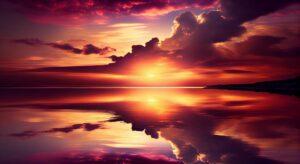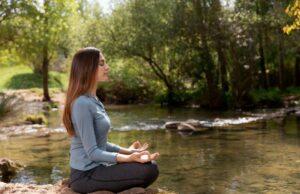In our fast-paced world, it can be challenging to quiet the mind and find relaxation. Whether it's the noise of the city, the constant barrage of technology, or the pressures of daily life, it's all too easy to become overwhelmed and stressed out. However, there are techniques you can use to find serenity and relaxation, even in the midst of chaos. One such technique is the art of visualisation, which has been used for centuries to help people quiet their minds, reduce anxiety, and promote overall well-being. Guided imagery is an instrumental component of visualisation, as it involves imagining calming and peaceful scenes or experiences that can help bring about a sense of tranquility. This practise can be especially beneficial for those who struggle with sleeplessness or who suffer from chronic pain, anxiety, or depression. In this blog post, I'll explore the art of visualisation and guided imagery, and provide tips on how to get the most out of this ancient technique.
Find a quiet and comfortable place to practise visualisation
Visualisation is a powerful tool for manifesting your desires and achieving your goals. It allows you to create a mental picture of the reality you want to experience and helps you attract it into your life. To practise visualisation effectively, it's important to find a quiet and comfortable place where you can relax and focus inward. This could be a cozy corner in your home, a peaceful park, or a quiet room at your workplace. Make sure that the space you choose is free from any distractions or interruptions so that you can fully immerse yourself in the practise of visualisation. Remember, by creating a serene environment for yourself, you can open the door to deeper levels of relaxation, self-awareness, and inner peace.
Close your eyes, take a few deep breaths, and let go of your worries.

In the hustle and bustle of daily life, it can be easy to get lost in the chaos and stress. That's where the art of visualisation comes in—with guided imagery, we can calm our minds and find a moment of peace. One technique is to simply close your eyes, take a few deep breaths, and let go of your worries. As you exhale, imagine them leaving your body, drifting away like clouds in a clear blue sky. It may take some practise to quiet your thoughts, but with time and patience, this simple exercise can help ease your stress and bring a sense of serenity to your day. So why not take a few moments right now to try it out? Close your eyes, take a deep breath, and feel the calm wash over you.
Progressive Muscle Relaxation
Progressive Muscle Relaxation (PMR) is a relaxation technique that helps relieve stress and anxiety. PMR involves systematically tensing and relaxing different muscle groups in the body, and is a great (but optional) addition to your visualisation exercise. Here are the steps if you want to try it.
-
Find a quiet and comfortable place to practise PMR. It can be a room, a quiet corner, or any space where you feel relaxed.
-
Sit or lie down in a comfortable position. Loosen any tight clothing or accessories that may restrict your breathing or movement.
-
Close your eyes and take a deep breath. As you exhale, release any tension in your body.
-
Begin with your feet. Tense the muscles in your feet by curling your toes downwards, and hold for a count of five. Then, release the tension and relax for a count of ten.
-
Move to your calves. Tense the muscles in your calves by pointing your toes upwards, and hold for a count of five. Then, release the tension and relax for a count of ten.
-
Continue to work your way up your body, tensing and relaxing each muscle group. Move to your thighs, buttocks, abdomen, back, chest, shoulders, arms, hands, neck, and finally your face.
-
Remember to breathe deeply and evenly throughout the exercise. Take slow, deep breaths as you tense the muscles, and then release the tension as you exhale.
-
Take your time with each muscle group. Focus on the sensation of tension and release in each muscle as you perform the exercise.
- After completing the exercise, lie still for a few moments and enjoy the feeling of relaxation in your body.
Visualize a peaceful place and let yourself be immersed in the landscape
Visualization is a powerful tool for achieving a sense of peace and relaxation. One effective technique is to visualise a peaceful place and let yourself be immersed in the landscape. Imagine a tranquil destination where stress and worries are left behind, and you are free to enjoy the beauty of nature. Visualise the calming sounds of a softly flowing stream or the gentle rustle of leaves. Imagine the warm sun on your skin, the fresh scent of flowers and grass, and the peacefulness that envelopes you. Allow yourself to be fully absorbed in the sights, sounds, and sensations of this peaceful retreat, and feel your body and mind relax into a state of calm serenity. With this technique, you can escape the chaos of daily life and find solace in a peaceful sanctuary, whenever and wherever you need it.

Focus on the details of the environment: the sights, sounds, smells, and feelings
When it comes to visualisation and guided imagery, one powerful technique is to focus on the details of your environment. This means taking the time to really notice the sights, sounds, smells, and feelings around you. As you close your eyes and let your imagination take over, allow yourself to fully immerse yourself in your imagined surroundings. Picture the colours of the sky, the texture of the ground beneath your feet, the gentle rustling of leaves in the wind, and the smell of fresh flowers or the salty sea air. By focusing on these details, you create a more vivid and realistic image in your mind, which can enhance your overall sense of relaxation and serenity. So, take a deep breath, let go of any distractions, and allow yourself to fully embrace the beauty of your surroundings through your mind's eye.
Invite a positive emotion to fill your meditation, such as joy, love, or hope
One of the most powerful ways to enhance your meditation practise is to invite positive emotions to fill your mind and body. When we focus on feelings of joy, love, or hope, we begin to shift our energy and mindset towards positivity and abundance. This can contribute to a greater sense of inner peace, relaxation, and serenity. As you begin your meditation practise, take a moment to set an intention to invite one of these positive emotions into your experience. Allow yourself to fully immerse in the feeling, visualise it spreading throughout your body, and notice how it transforms your mental and physical state. Remember, you have the power to choose your thoughts and emotions, so why not choose the ones that serve your highest good? Let your meditation practise be a time to cultivate positivity, and watch as it transforms your life.
Allow yourself to relax and be open to the process

We often get so caught up in our daily lives, constantly pushing ourselves to excel, that we forget to take time to exhale and unwind. But rest assured, taking a step back and giving yourself the space and time to embrace the power of visualisation can have tremendous benefits for your mental and emotional health. So, let yourself sink into your surroundings and let your mind drift away as you focus on your intention. Trust the process, and let your mind and body do the work to bring peace, tranquility, and serenity into your life. You'll be amazed at the difference it can make.
Pay attention to the sensations in your body as you become more relaxed
It's important to pay attention to the sensations in your body that come with relaxation. As you become more relaxed, you may notice a feeling of warmth spreading throughout your body, or a sense of lightness and ease. Maybe you feel your muscles releasing tension, or your heart rate slowing down. Whatever the sensation, let it wash over you and deepen your sense of relaxation even further. By focusing on the positive physical sensations that come with relaxation, you'll be better equipped to handle stress and anxiety when they arise in the future. Remember that the art of visualisation and guided imagery is a powerful tool you can use to create a sense of serenity and calm in your life. Keep practising, and see how much more relaxed and centred you feel every day.
Picture yourself in the environment for as long as you need
One effective technique to enhance your visualisation skills and create a lasting impact on your subconscious mind is to picture yourself in the environment you desire for as long as you need. Whether you want to gain more confidence, improve your health, or meet your personal and professional goals, taking some time to immerse yourself in your ideal scene can help you access the deepest parts of your mind and tap into your innate creative potential. By using this technique, you can visualise yourself in the environment you desire in vivid detail, feel the emotions associated with that experience, and start to manifest it into your reality. So take a deep breath, close your eyes, and imagine yourself surrounded by the beauty, love, and abundance that you deserve. Your mind is a powerful tool, and by mastering the art of visualisation, you can unlock its full potential to create the life of your dreams.
When your visualisation is finished, take a moment to reflect on the experience
When you finish your visualisation practise, take a few moments to reflect on the experience. Consider the thoughts, emotions, and sensations that arose during the exercise. Take note of any feelings of calmness, clarity, or positive energy you may be experiencing. Allow yourself to fully absorb and appreciate the experience of your guided imagery practise. This reflection time is an opportunity to deepen your connection with yourself, and to acknowledge the power of your thoughts and imagination. Remember that visualisation exercises are a valuable tool for relaxation and serenity, and they can be incorporated into your daily routine to help you stay centred and focused on your goals. With consistent practise and a positive mindset, you can harness the full potential of visualisation to transform your life in ways you never thought possible.
Open your eyes and feel the positive energy that lingers from your visualisation journey.
The art of visualisation is a powerful tool for relaxation and serenity. As you journey through your visualisation practise, you will notice that positive energy surrounds you. It's important to open your eyes and take in the beauty of your surroundings. Allow the positive energy to engulf you and provide you with a renewed sense of vitality. Let yourself be present in the moment and feel the joy in your heart. Remember that this journey is yours and yours alone, and that the positive energy you feel is a direct result of your own visualisation efforts. So embrace this energy, and let it guide you to your ultimate bliss. Your mind is a powerful tool, and with the art of visualisation, you can unlock its potential and find peace and harmony in your life.
Summing Up
Visualisation and guided imagery can be powerful tools for promoting relaxation, reducing stress, and cultivating inner peace. By accessing the limitless power of our imagination, we can tap into an abundant source of creativity, inspiration, and healing energy. Whether you're struggling with anxiety, depression, or simply looking for a way to unwind after a long day, incorporating guided imagery into your daily routine can help you tap into the power of your own mind to find comfort, clarity, and a greater sense of serenity. So why not give it a try and see what kind of magic unfolds?

More Posts for Serenity
 | Steve Cato is a PhD-level scientist who brings a strong scientific perspective to the study of mind improvement. |
Semantically Related Posts
However, it's essential to choose the right type of music for your practice. Avoid songs with lyrics or upbeat tempos, as they can be distracting and make it difficult to concentrate on your visualisation. You may also want to experiment with different types of music to find what works best for you.
Keep in mind that some individuals may prefer silence or find music distracting during their visualisation sessions. Ultimately, it's a personal preference, and you should choose the approach that feels most comfortable and effective for you.
 | Science of Subliminal Messaging for Self-Help | Embracing Stoicism: A Master Key to Inner Calm |  |












